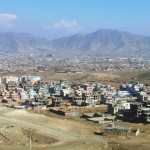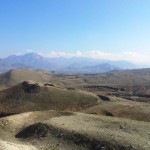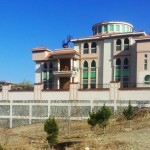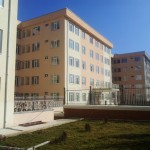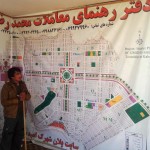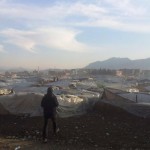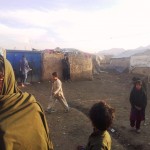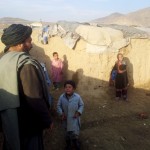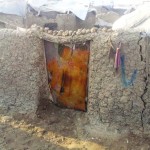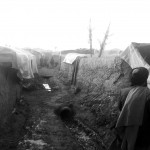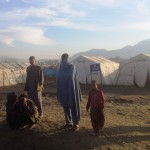Today we first went to visit the new city of Omid-e Sabz. It is located improbably far from the city center, about 10 minutes drive West of Darulaman Palace, and close to the southeastern rim of Dasht-e Barchi.

In a way it’s lucky Kabul is surrounded by mountains, otherwise the city would never stop expanding.
Omid-e Sabz means ‘Green Hope’. The land was bought, developed and sold by the brother of Vice-President Khalili. The project began seven years ago and according to the commercial representative we spoke to, the 6000 plots have now been sold. It’s supposed to be an Afghan model town, and it is often praised on TV ads and billboards.
However there are questions raised about the legality of the project. According to Kabul Municipality most of the construction activities there are illegal, despite many senior government officials having bought land there. Tensions about land tenure erupted between the Kochi nomads who used to use the land for grazing and the Hazaras who run the town.
A plot costs between 120.000 and 200.000 USD. According to the masterplan the roads should be paved and there are parks, schools, cultural and sport amenities and many commercial activities. But there is little to be seen, and one wonders, now the plots have been sold, what the incentive is for the project owners to fulfill their promises. The town is eerily quiet, there are hardly any shops and most of the built houses are empty.
There seem to be many empty palaces in and around Kabul. It makes one wonder why the newly affluent Afghans have such a strong desire to invest in real estate. Surely, building (or buying) an impossibly big house that rapidly deteriorates, and which no one wants to / can afford to live in, is not such a good investment? Who will buy the house below, which cost 3 to 400,000 USD to build on a 200.000 USD plot of land, and which the owner wants to sell for 1,000,000 USD?
- Part of the new Omid-e Sabz city
- Landscape behind Omid e Sabz
- A one million dollar house
- Apartment blocks in Omed-e Sabz
- The plan for Omed-e Sabz with the real estate agent
After speaking at length to the commercial representative, who was in complete denial about the incompleteness of the project, we drove on bumpy roads through the endless stretches of Dasht-e Barchi, a very big Hazara settlement that used to be on the southwestern edge of Kabul, but which is now surrounded on most sides – as far as the eye can see – by new neighborhoods.
Above are some of the brick kilns in Dasht-e Barchi.
We then drove back through town, past the square commemorating the Hazara commander and politician Mazari, assassinated by the Taliban, the first flyover and the ‘Silo’ to the refugee camps on Charahi Qambar, which lie next to the main road towards Kargha.
When we got out of the car at the refugee camp we felt a bit of trepidation. The first old men we spoke to, who were selling pomegrenates along the road side, told us they lived in the camp, and that they were from Kandahar. When I asked them what had made them flee their province they exclaimed: “your people, your bombings”.
According to some data there are about 50.000 refugees from the Southwest in these camps. They have fled the violence, and some of them say they have been here for five or seven years. The ISAF/NATO intensive bombing of rebel-held areas, as well as exactions by the Taliban, have made their life impossible (see a good 2010 RAWA report about the reasons for fleeing here). But the camp representative, who guided us through the camp, told us that interethnic strife was also a reason.
He, a Nurzai from Sangin in Helmand, said that his group was involved in a long blood feud with Achakzai and Barakzai neighbors. The honor killings had been going on for a long time now and the debts/conflicts were too great. He didn’t contemplate returning to Sangin district, even if the fighting between the opposing sides would stop. “We’re going to stay here forever” he said.
He complained bitterly about the squalid living conditions and the lack of aid. In his camp of 975 households there was a small field clinic and only two tents for schools, which could hold 80 boys. They had no income he said, and their self-built mudwalled ‘houses’ were in a very poor condition. He kept insisting there was ‘no’ foreign aid; what he meant was probably that there was not enough, because they had UNHCR cards and UN-funded facilities.
Towards the end of our tour of the refugee camp we spoke with a smartly dressed young student who regretted we were not Muslims ‘because then we could really become friends’. He also said he had no intention of returning to Helmand, but not because it was impossible, but because ‘here in Kabul we can get a good education, our children can get a good education and therefore a better life’.
- The camp of refugees from Kandahar and Helmand in Charai-ye Kanbar
- Entrance to the refugee camp
- There are purportedly 975 households in the camp
- A house in the refugee camp
- Squalid roads, no drainage or infrastructure
- The camp representative Wakil Toorzai showing the wear of the tarpaulins
- The camp clinic and two school tents alongside the main road
END

